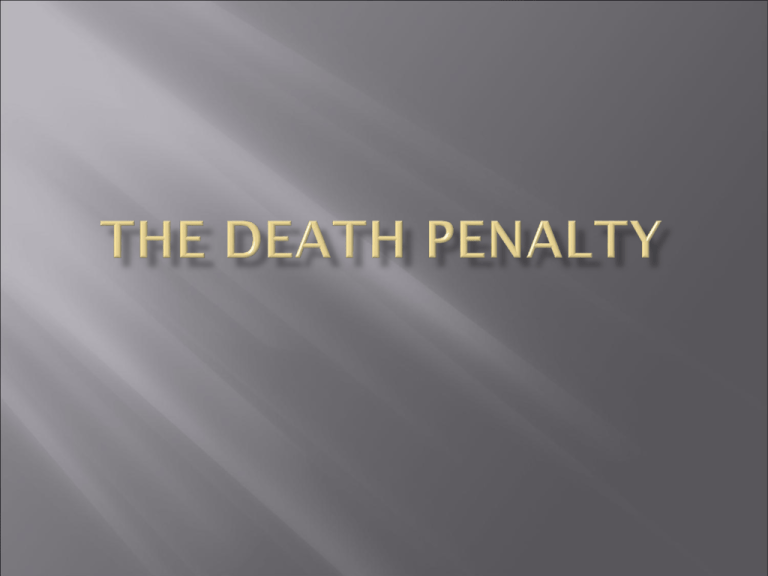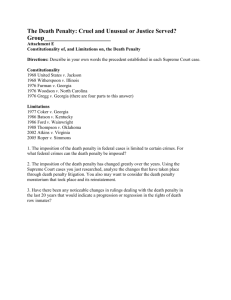
Alabama, Arizona, Arkansas, California, Colorado,
Connecticut, Delaware, Florida, Georgia, Idaho,
Illinois, Indiana, Kansas, Kentucky, Louisiana,
Maryland, Mississippi, Missouri, Montana,
Nebraska, Nevada, New Hampshire, New Mexico,
North Carolina, Ohio, Oklahoma, Oregon,
Pennsylvania, South Carolina, South Dakota,
Tennessee, Texas, Utah, Virginia, Washington,
Wyoming, United States Government, United States
Military
Alaska, Hawaii, Iowa, Maine, Massachusetts,
New Jersey, New York, North Dakota, Rhode
Island, Vermont, West Virginia, Wisconsin,
District of Columbia
A May 2006 Gallup
Poll revealed that
overall support for
the death penalty
was 65% (in 1994 it
was 80%).
Results of the choice
between life without
parole or the death
penalty are shown to
the right.
The death penalty statutes vary depending on the
state, but all involve murder.
Other crimes punishable are:
Second conviction for rape of a child under 14(Texas, Oklahoma)
Repeat offenders of criminal sexual conduct with a minor under
11 (South Carolina)
Second conviction for sexual intercourse without consent
accompanied by serious bodily injury (Montana)
Aggravated rape of a child under 13 (Louisiana)
Sexual battery or attempted sexual battery with injury of a child
under 12 (Florida)
Carnal knowledge of a female who is less than 10 presumes force
(Georgia)
Treason
(Arkansas, California, Colorado, Georgia, Illinois,
Louisiana, Mississippi, Missouri, Washington)
Aggravated kidnapping (Colorado, Idaho, Illinois, Missouri,
Montana)
Drug trafficking
(Florida, Missouri)
Aircraft hijacking
(Georgia, Montana)
Placing a bomb near a bus terminal
(Montana)
Espionage
(New Mexico)
Aggravated assault by incarcerated, persistent felons, or
murderers (Montana)
The first established death penalty laws were in
the 18th Century B.C. in the Code of King
Hammaurabi of Babylon. The code qualified the
death penalty as punishment for 25 different
crimes.
In the 11th Century A.D. William the Conqueror
prohibited the execution for any crime other than
murder.
English settlers brought the death penalty from
Britain with them when they came to America.
First recorded execution in the colonies was of
Captain George Kendall in 1608 for being a spy for
Spain.
Opposition to the death penalty first started in
1767 with the essay On Crimes and Punishment by
Cesare Beccaria. He theorized that there was no
justification for execution.
In the early 1800s states began to reduce the
number of capital crimes and build state
penitentiaries.
In 1834, Pennsylvania became the first state to
move executions from the public into correctional
facilities.
Some states began to abolish the death penalty
In the 1950s support and use of the death penalty
dropped dramatically.
Before the 1960s the 5th, 8th, and 14th Amendment was
interpreted as allowing the death penalty.
In the 1960s the legality of the death penalty was
questioned.
In Witherspoon v. Illinois (1968) the Supreme Court
ruled that potential jurors could not be dismissed
solely because of opposition to the death penalty.
In Furman v. Georgia (1972) Supreme Court ruled that
the death penalty statute violated the 8th Amendment.
On June 29, 1972, the Supreme Court voided 40 death
penalty statutes and suspended the death penalty.
In Gregg v. Georgia (1976) the Supreme Court reinstated
the death penalty and ruled that the death penalty was
constitutional under the 8th Amendment.
Lethal injection
Electrocution
11 people since 1976
Hanging
154 people since 1976
Gas Chamber
932 people since 1976
3 people since 1976
Firing Squad
2 people since 1976
Oklahoma was first state to adopt lethal injection
in 1977.
First person to be executed by lethal injection was
Charles Brooks in Texas on December 2, 1982.
Person is bound to gurney and heart monitors are position
on skin.
Two needles (one is back-up) are inserted into veins in the
arm. Long tubes are connected to several intravenous drips.
First drip is a saline solution that is harmless.
The inmate is then injected with sodium thiopental (an
anesthetic) to put the inmate to sleep.
Pavulon or pancuronium bromide is injected to paralyze the
muscle system and to stop the inmate’s breathing.
Potassium chloride is finally injected to stop the heart.
Death is caused from anesthetic overdose, respiratory arrest
and cardiac arrest while the person is unconscious.
Medical ethics do not
allow doctors to
participate in executions.
Doctors can only certify if
the inmate is dead or not.
Inexperienced technicians
and orderlies perform the
injections.
If the drugs are injected
into a muscle or if the
needle becomes clogged,
the inmate will experience
extreme pain.
New York built the first electric chair in 1888 as a
more humane method of execution than hanging.
First person to be executed by electric chair was
William Kemmler in 1890.
The electric chair in the sole method of execution
in Nebraska.
Person is shaved and strapped to chair with belts that cross
the chest, groin, legs and arms.
A metal skullcap-shaped electrode is attached to the scalp
and forehead over a sponge moistened with saline.
If sponge is too wet it will short-circuit the electric current.
If sponge is too dry the electric current will have a very high
resistance.
An electrode moistened with conduction jelly is attached to
the leg.
The prisoner is then blindfolded.
A Handel that connects to power supply is pulled and a jolt
between 500 and 2000 volts (about 30 seconds) is given.
Doctors wait for body to cool down and check to see if the
inmate’s heart is still beating. If it is, another jolt is applied.
This process continues until the prisoner is dead.
Extremely painful and
brutal way to die:
Prisoner’s hands often
grip the chair and violent
movement can sometimes
cause dislocations and
fractures.
The tissues swell and
bowels empty.
Steam and smoke rise
from prisoner with the
smell of burning.
Eyeballs sometimes pop
out and rest on the cheeks.
Prisoner often urinates,
vomits blood and drools.
Body turns bright red and
the skin stretches to the
point of breaking.
Prisoner sometimes catches
fire.
After death, body is hot
enough to blister if touched.
Third degree burns occur
where the electrodes met
the skin.
In most cases, the brain
appears cooked at autopsy.
Nevada first used cyanide
gas in 1924 as a more
humane way of execution.
First person to be executed
by lethal gas was Gee Jon.
Cyanide gas was pumped
into his cell while he slept,
but gas leaked from his cell.
Gas chamber was built as a
result.
Inmate is strapped to a chair in an airtight chamber. Below
chair is a pail of sulfuric acid.
Long stethoscope is attached to inmate so doctor outside
chamber can pronounce death.
Room is sealed and a lever is pressed.
Lever releases hydrogen cyanide gas into chamber.
Inmate is instructed to breathe in deeply to speed up
process.
Inmate does not lose consciousness immediately.
Inmate’s eyes pop, the skin turns purple and the inmate
begins to drool.
Inmate dies from hypoxia (cutting off of oxygen to the
brain)
Once person is dead, an exhaust fan sucks the poison air out
of the chamber and the corpse is sprayed with ammonia to
neutralize any cyanide left over.
Federal court in
California found
method to be a cruel
and unusual
punishment.
Inmate does not lose
consciousness
immediately.
Inmate exhibits signs
of extreme horror,
pain and strangling.
Doctors say the
people are
unquestionably
experience pain and
extreme anxiety.
Hanging was primary method of execution until the
1890s.
Delaware and Washington still use hanging.
Day before execution the inmate is weighed and a rehearsal
is done using a sandbag with same weight. The rehearsal
helps determine the length of “drop” needed for a quick
death.
The rope is boiled and stretched to eliminate spring or
coiling.
The knot is lubricated with wax or soap so it can slide
smoothly.
Inmate’s hands and legs secured
Inmate is blindfolded.
The noose is placed around neck with knot behind ear.
Trap-door is opened and inmate falls through.
Inmate’s weight should cause a rapid fracture/dislocation
of the neck.
Instantaneous death
rarely occurs.
If rope is too long,
inmate could be
decapitated.
Death can result from
slow asphyxiation if:
Inmate has strong neck
muscles
Has a light weight
Noose is positioned
wrong
Fracture/dislocation is
not rapid
If rope is too short,
strangulation could take
up to 45 minutes.
If slow asphyxiation
occurs:
The face becomes
engorged
The tongue sticks out
The eyes pop
The bowels empty
Violent movements of
the limbs occur
Firing squad is still a method of execution in
Idaho.
Last person to be executed by firing squad was
John Albert Taylor in Utah on January 26, 1996.
The chair above was used in this execution.
Inmate is bound to chair with leather straps across
waist and head.
Chair is surrounded with sandbags to absorb
blood.
Black hood is put over the inmate’s head.
Doctor locates heart and pins a white cloth target
over it.
Standing 20 feet away, five shooters armed with
0.30 caliber rifles shoot at the inmate. One of the
rifles contains a blank round.
Inmate dies from loss of blood.
Not all inmates lose
consciousness
immediately.
If shooters
accidentally miss
heart, the inmate
bleeds to death
slowly.
Shooters sometimes
intentionally miss
heart so the inmate
suffers.
One of the shooters is
given blank rounds.
Shooters can feel that
they were not
responsible.
Women
Mental Retardation
Mental Illness
Juveniles
Religion
Race
Native Americans
Deterrence
Actual executions of women are rare.
First execution of a woman was in 1632.
There are only 568 documented executions of
women, making up 2.8% of total executions since
1608.
As of December 31, 2007, there were 51 women on
death row.
This constitutes 1.5% of the total death row population
In the past 100 years, over 40 women have been
executed, including 11 since 1976.
9 by lethal injection
2 by electrocution
Mental health experts state that mentally
retarded people have the characteristic of
wanting to please which leads them to confess
(sometimes falsely) to capital crimes.
On June 20, 2002 in Atkins v. Virginia, the
Supreme Court ruled that it is a violation of the
8th Amendment ban on cruel and unusual
punishment to execute inmates with mental
retardation.
Since then, a national consensus has been made
on the issue, which supports the 2002 ruling.
Mental illness is classified
as
“Any of the various
conditions characterized by
impairment of an individual’s
normal cognitive, emotional
or behavioral functioning.”
The most common mental
illnesses found in prisons
are:
bipolar disorder,
borderline personality
disorder, schizophrenia,
and suicide
Research by the Bureau of
Justice Statistics found
that 1 in 6 prisoners has a
history of a mental illness
Resolutions have been
made that call for the
exemption for the
mentally ill by:
American Psychiatric
Association
American Psychological
Association
National Alliance for the
Mentally Ill
American Bar Association
First execution of a juvenile was in 1642.
Since 1642, approximately 365 people have
been executed for juvenile crimes, which makes
up 1.8% of all executions.
Since the 1976, 22 juvenile offenders have been
executed, which is about 2% of all executions.
In March 2005, in Roper v. Simmons the
Supreme Court ruled that the death penalty for
those who committed crimes under the age of
18 was a cruel and unusual punishment and
was barred by the Constitution.
Religious activists work to abolish the death penalty
Religions that support death penalty:
The Christian Coalition
Fundamentalist churches
Pentecostal churches
Religions that oppose death penalty:
Roman Catholic Church
Most Protestant denominations:
Baptists, Episcopalians, Lutherans, Methodists,
Presbyterians, and the United Church of Christ
Religions that are indifferent:
The Church of Jesus Christ of Latter-day Saints
In 96% of states reviewed
for the death penalty there
was a pattern of race-of
victim or race-ofdefendant discrimination,
or both.
A study conducted in
North Carolina found that
the odds of receiving the
death penalty rose by 3.5
times if the victim was
white.
A study in California
found that people who
killed whites were 3 times
more likely to get the
death penalty than those
who killed blacks and 4
times more likely than
those who killed Latinos.
In the death penalty states, 98% of the chief
district attorneys are white and only 1% are
black.
In McCleskey v. Kemp (1987) the Supreme Court
ruled that racial disparities would not be
recognized as a constitutional violation of
“equal protection under law” unless intentional
racial discrimination against the defendant
could be shown.
The Native American crime
victimization rate is double
the rate of non-Indians.
The incarceration rate of
Native Americans is 19%
higher than the national rate.
Native Americans typically
receive longer sentences than
non-Indians and tend to
serve longer time in prison.
They are also subject to
abuse from other inmate
because of cultural reasons.
In 2006, Native Americans
made up 1.1% of total death
row population.
Since 1961, 15 American
Indians have been executed.
Between 1979-1999 whites
were responsible for 32% of
the Native Americans killed,
while Indians were
responsible for only 1% of
whites killed.
The method of execution for Native Americans is
typically more brutal than the method of whites, which
is usually lethal injection:
Murder Rates in Death Penalty and Non-Death Penalty States
Studies found that the murder rates in death
penalty states are consistently higher than in nondeath penalty states:
Law enforcement
officers place the
death penalty last in
deterring violent
crime.
Criminologists do not
think that the death
penalty acts as a
deterrence to murder.
36 states allow death
penalty
14 states prohibit
death penalty
Methods of execution
are painful to the
inmates
Question of whether it
is a “cruel and unusual
punishment.”
The mentally retarded
and juveniles are
exempt from death
penalty.
Women are less likely
to receive death
penalty
Racial discrimination
occurs
Death penalty does
not act as a deterrence










